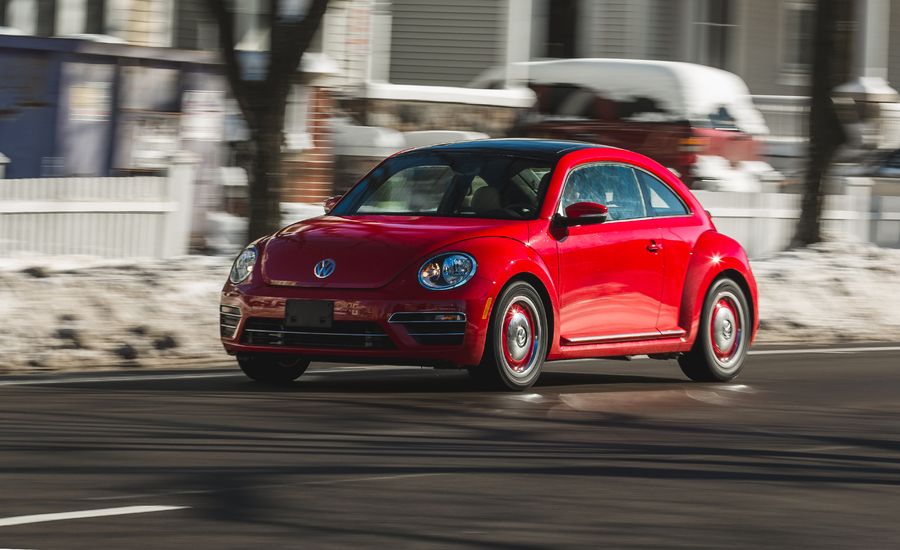
You wouldn’t know by looking at it, but the 2018 Volkswagen Beetle has a new heart. The retro-styled hatchback and its convertible counterpart swap last year’s 170-hp turbocharged 1.8-liter inline-four for a 174-hp turbo 2.0-liter four that can run on a modified version of the more efficient Miller cycle. This new 2.0-liter is not to be confused with the 210-hp turbocharged 2.0-liter four-cylinder offered in top trims of the 2017 Beetle; that engine has since been discontinued.
Along with its modest power bump, the larger-displacement engine helps the Beetle earn an EPA-estimated city fuel-economy figure of 26 mpg, a 2-mpg improvement over the 1.8-liter. Highway ratings hold steady at 33 mpg in S and SE models, while the Baja Bug–inspired Dune earns a 34-mpg highway rating. We averaged 26 mpg in this Beetle through more than 1000 miles of driving, and the hatchback also returned 33 mpg on our 75-mph highway fuel-economy test.

The powertrain isn’t the only change to the 2018 Beetle, as the model welcomes a new Coast trim to the lineup; our car was equipped with this package. The $23,970 Coast is based on the entry-level $21,070 Beetle S and adds niceties such as a sunroof, a proximity key with push-button start, heated front seats, a 6.3-inch touchscreen infotainment system, and blind-spot monitoring with rear cross-traffic alert, as well as trim-specific features such as faux-wood dashboard trim and houndstooth-pattern cloth seats. Last year’s kitschy Classic, luxury-oriented SEL, and sporty R-Line SEL trims have been discontinued.
Coast to Coast
The Beetle Coast proved an affable companion as we moseyed around the snow-covered streets of southeast Michigan and puttered about the pockmarked lanes of I-94 on the way to our nation’s third coast: the shores of Lake Michigan.
Even on Hankook Kinergy GT all-season tires, the Beetle held its own as it blasted through the thick pockets of snow and slush that matted the roads surrounding the Great Lake. Precise steering and a well-damped independent suspension front and rear helped the softly sprung Beetle remain lively enough so as not to be dull. Although the Beetle may not be as fun to pilot as a Mini Cooper Hardtop or a Volkswagen Golf, it’s certainly not a penalty box.

That said, we wish Volkswagen still sold the hunchbacked hatch with a manual gearbox. As it stands, the Beetle is restricted to a lackadaisical six-speed automatic transmission. Passing at highway speeds is a laborious affair, and this Beetle needed 5.7 seconds to get from 50 to 70 mph, or 0.8 second longer than an equally powerful Honda Civic 1.5T sedan equipped with a continuously variable automatic transmission. Thanks to its well of low-end torque (all 184 lb-ft of which is available at just 1500 rpm), the Beetle feels far livelier at slower speeds, as evidenced by its 3.8-second 30-to-50-mph passing time, which topped the Civic by 0.1 second.
Likewise, the Beetle squirts off the line with reasonable assurance. The stride to 60 mph required 7.2 seconds, and the quarter-mile was eclipsed in 15.6 seconds at 91 mph. The former figure bettered that of a 13-pound-lighter, high-riding Beetle Dune equipped with the old 1.8T engine by 0.2 second. Both Beetles recorded the same quarter-mile time and required 167 feet of tarmac to come to a stop from 70 mph.
Smile for Style
The Beetle remains a style statement above all else, and its bulbous fenders, raked rear end, and round headlights are unmistakable nods to the original model. Nostalgia abounds inside, too, in the form of the Beetle’s horizontal upper-dashboard design and available secondary glovebox.

Although its retro looks and relatively affordable pricing put the Beetle in contention with vehicles such as the Mini Cooper Hardtop and the Fiat 500, the Volkswagen is noticeably larger, casting a shadow more than a foot longer than the Mini and more than two feet beyond the Fiat. The Beetle’s larger footprint is a boon to passenger space, and its back seats are substantially more comfortable than those of the Fiat and the Mini. Additionally, the Beetle’s 15-cubic-foot cargo hold betters those of the 500 and the Mini by 5 and 6 cubes, respectively.
However, everything the Beetle can do, the Golf hatchback can do better. Its back seat is more spacious, its cargo area is more voluminous, and its chassis is both more composed over road irregularities and livelier over twisty tarmac. Furthermore, the four-door Golf is available with a manual transmission, and its cabin is crafted with richer materials. The $21,760 Golf may look a lot less interesting than the Beetle, but in every other way it’s the superior compact Volkswagen hatchback. You’ve gotta like touches like the Coast’s retro eye candy an awful lot to pluck this particular shell from the dealer’s beach.
No comments:
Post a Comment